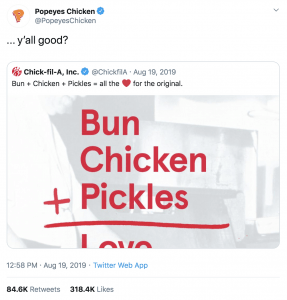Brands on Twitter: They Beef, They Roast, and They Beef Some More
Why PR pros should consume their daily beef
Published on February 10, 2020, at 10:19 p.m.
by Faith Saucier.
Brands on Twitter have been beefing, bantering and building their personalities since the micro-blog site rose to popularity in 2013, and they are not showing any signs of stopping.
Seven years after its birth into the world of social media, Twitter experienced exponential growth, with its number of users increasing by nearly 100 million from 2012 to 2013. Today, the powerhouse social media platform engages 330 million total users, providing brands with a unique opportunity to up their social media game like they never have before.
That’s right — it’s time to start following in the footsteps of the brands who have made savvy out of social media sass.
Take Wendy’s, for example. It possesses one of the highest followings of any fast-food account on Twitter — yes, that’s 3.5 million — and its social media team is doing everything right.
Last year, the corporation created its own day of roasting, hashtagged #NationalRoastDay, asking followers to volunteer themselves to be personally and publicly attacked by the account. Users lined up like chickens waiting for slaughter.
However, Wendy’s does not spend all of its time roasting only its followers — it roasts its competition, too. In 2020 alone, two tweets from the infamous Wendy’s account have gone viral.
On Jan. 23, Twitter user Adam Fyn posted a photo of a McDonald’s truck and tagged Wendy’s, asking “@Wendys what would you call this?” The response was everything that a loyal, beef-hungry Wendy’s follower could have asked for. The company’s reply, which stated, “Is it a garbage truck?” received laughs and praise from millions, and boasts 152,000 retweets and a whopping one million likes as of Feb. 10.

The second tweet was yet another response to an everyday Twitter user who posted a photo of two Mickey-D’s workers dumping trash into a nearby dumpster outside one of its restaurants. April Dunn tweeted at Wendy’s with the photo and said, “@Wendys what do you think they’re doing here?”
The company’s response? “Picking up their order.” Excellent. Just excellent.
As you may have guessed, other companies have also taken their seats on the beef train and won’t be getting off anytime soon.

In August of 2019, the ever-conservative Chick-fil-A made a pass at the authenticity of the new Popeyes chicken sandwich in a tweet that said, “Bun + Chicken + Pickles = all the [heart emoji] for the original.” Popeyes — with only 220,000 Twitter followers as of Feb. 10 — quoted Chick-fil-A’s tweet and said, “… y’all good?”
Yes, Popeyes did call out the largest chicken producer in the United States on Twitter; yes, its total number of followers did spike after the tweet; and yes, its tweet on Aug. 19 did receive 84,000 retweets and 318,000 likes (more than its total number of followers).
Now, you might be wondering why on earth it is acceptable for brands to interact with their followers, and with each other, this way on Twitter. But, with high risk comes high reward. Popeyes gained 25,000 followers after its Chick-fil-A roast session, and, in just the last six months, Wendy’s Twitter following has increased by nearly 350,000 users.
Your brand personality — with all its sassing and roasting — can serve as an engine to engage Twitter users and connect them to your brand. It might even make your followers look forward to seeing your tweets every day.
Now that’s something I’d say is worth beefing over.




